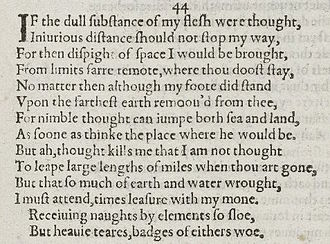Sonnet 44
| Sonnet 44 | |||||||
|---|---|---|---|---|---|---|---|
 Sonnet 44 in the 1609 Quarto | |||||||
| |||||||
Sonnet 44 is one of 154 sonnets written by the English playwright and poet William Shakespeare. It is a member of the Fair Youth sequence, in which the poet expresses his love towards a young man. Sonnet 44 is continued in Sonnet 45.
Structure[]
Sonnet 44 is an English or Shakespearean sonnet, which contains three quatrains followed by a final rhyming couplet. It follows the typical rhyme scheme of the form, ABAB CDCD EFEF GG, and is written in iambic pentameter, a type of poetic metre based on five pairs of metrically weak/strong syllabic positions. The fifth line exemplifies a regular iambic pentameter:
× / × / × / × / × / No matter then although my foot did stand (44.5)
- / = ictus, a metrically strong syllabic position. × = nonictus.
The sonnet is quite regular metrically (for example, a three-syllable "injurious" maintains regularity in line two), but implements a few variations, for example in the first and last lines:
× × / / × / × / × / If the dull substance of my flesh were thought, (44.1) × / × / / × × / × / But heavy tears, badges of either's woe. (44.14)
...which contain, respectively, a rightward movement of the first ictus (resulting in a four-position figure, × × / /, sometimes referred to as a minor ionic), and a mid-line reversal ("badges").
Criticism[]
Critics have mentioned Sonnet 44 is directly coupled to Sonnet 45 and lacks a definite conclusion.[2]
Recordings[]
- Poeterra, for the 2014 album, When in Disgrace
- Paul Kelly, for the 2016 album, Seven Sonnets & a Song
References[]
- ^ Pooler, C[harles] Knox, ed. (1918). The Works of Shakespeare: Sonnets. The Arden Shakespeare [1st series]. London: Methuen & Company. OCLC 4770201.
- ^ Fineman, Joel (1986). Shakespeare's Perjured Eye: The Invention of Poetic Subjectivity in the Sonnets. Univ of California Press. pp. 227–229. ISBN 0520054865. Retrieved 1 May 2015.
Further reading[]
- First edition and facsimile
- Shakespeare, William (1609). Shake-speares Sonnets: Never Before Imprinted. London: Thomas Thorpe.
- Lee, Sidney, ed. (1905). Shakespeares Sonnets: Being a reproduction in facsimile of the first edition. Oxford: Clarendon Press. OCLC 458829162.
- Variorum editions
- Alden, Raymond Macdonald, ed. (1916). The Sonnets of Shakespeare. Boston: Houghton Mifflin Harcourt. OCLC 234756.
- Rollins, Hyder Edward, ed. (1944). A New Variorum Edition of Shakespeare: The Sonnets [2 Volumes]. Philadelphia: J. B. Lippincott & Co. OCLC 6028485.
- Modern critical editions
- Atkins, Carl D., ed. (2007). Shakespeare's Sonnets: With Three Hundred Years of Commentary. Madison: Fairleigh Dickinson University Press. ISBN 978-0-8386-4163-7. OCLC 86090499.
- Booth, Stephen, ed. (2000) [1st ed. 1977]. Shakespeare's Sonnets (Rev. ed.). New Haven: Yale Nota Bene. ISBN 0-300-01959-9. OCLC 2968040.
- Burrow, Colin, ed. (2002). The Complete Sonnets and Poems. The Oxford Shakespeare. Oxford: Oxford University Press. ISBN 978-0192819338. OCLC 48532938.
- Duncan-Jones, Katherine, ed. (2010) [1st ed. 1997]. Shakespeare's Sonnets. The Arden Shakespeare, Third Series (Rev. ed.). London: Bloomsbury. ISBN 978-1-4080-1797-5. OCLC 755065951.
- Evans, G. Blakemore, ed. (1996). The Sonnets. The New Cambridge Shakespeare. Cambridge: Cambridge University Press. ISBN 978-0521294034. OCLC 32272082.
- Kerrigan, John, ed. (1995) [1st ed. 1986]. The Sonnets ; and, A Lover's Complaint. New Penguin Shakespeare (Rev. ed.). Penguin Books. ISBN 0-14-070732-8. OCLC 15018446.
- Mowat, Barbara A.; Werstine, Paul, eds. (2006). Shakespeare's Sonnets & Poems. Folger Shakespeare Library. New York: Washington Square Press. ISBN 978-0743273282. OCLC 64594469.
- Orgel, Stephen, ed. (2001). The Sonnets. The Pelican Shakespeare (Rev. ed.). New York: Penguin Books. ISBN 978-0140714531. OCLC 46683809.
- Vendler, Helen, ed. (1997). The Art of Shakespeare's Sonnets. Cambridge, MA: The Belknap Press of Harvard University Press. ISBN 0-674-63712-7. OCLC 36806589.
External links[]
- British poems
- Sonnets by William Shakespeare

